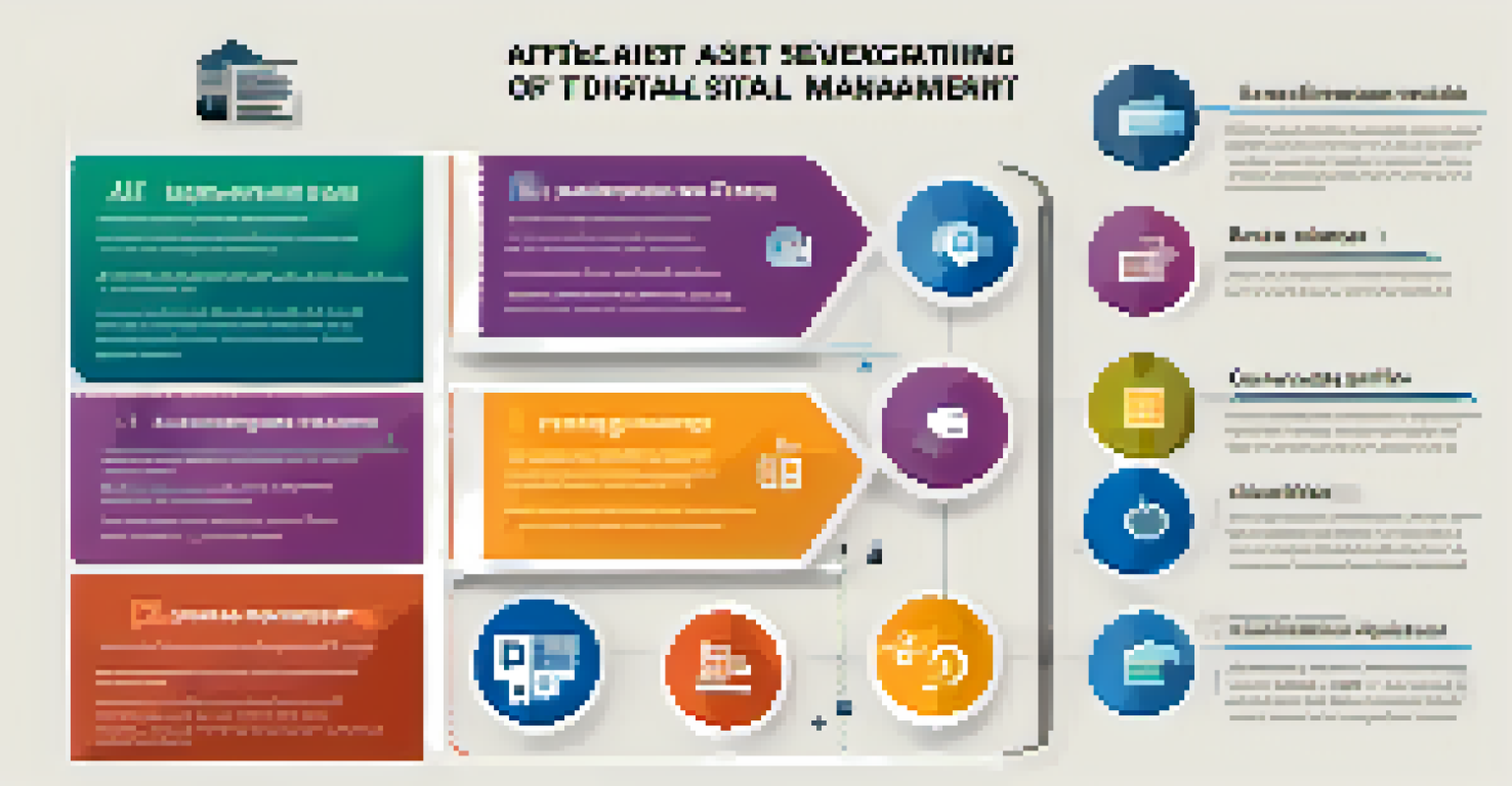How Digital Asset Management Improves Team Collaboration

Understanding Digital Asset Management (DAM)
Digital Asset Management (DAM) is a system that helps organizations store, organize, and share their digital assets, such as images, videos, and documents. Think of it as a digital library where your team can easily find and access the content they need without sifting through endless folders. By centralizing these assets, DAM provides a unified platform that enhances both efficiency and productivity.
The more we can share our work, the better it will be. Collaboration unlocks creativity.
Imagine a marketing team preparing for a product launch. With DAM, they can quickly locate the latest promotional images and videos, ensuring everyone is on the same page. This streamlined access reduces time spent searching for files, allowing team members to focus on more strategic tasks, such as developing creative campaigns.
Moreover, DAM systems often come with powerful search features that allow users to filter assets by tags, categories, or even metadata. This capability not only speeds up the retrieval process but also empowers team members to be more self-sufficient in their work.
Improved Communication Through Access to Assets
When teams have access to the same pool of digital assets, communication becomes more straightforward. Team members can easily share files without the confusion of outdated versions or miscommunication about which assets to use. This clarity fosters collaboration, as everyone can contribute ideas and feedback based on the same materials.

For example, consider a design team collaborating with content writers. When both teams access the latest graphics and copy from a DAM system, they can provide timely and constructive feedback. This collaborative environment not only enhances creativity but also helps maintain brand consistency across different channels.
Streamlined Access to Digital Assets
Digital Asset Management (DAM) centralizes assets, making it easier for teams to find and utilize the latest materials efficiently.
Additionally, having a single source of truth reduces the likelihood of errors. Team members can trust that they are working with the most current assets, which minimizes the risk of using outdated or incorrect information in their projects.
Streamlining Workflows with DAM Solutions
Digital Asset Management systems can significantly streamline workflows by automating repetitive tasks. For instance, automated tagging and categorization of assets save time and ensure consistency in how files are organized. This means team members can spend less time managing assets and more time on their core responsibilities.
Consistency breeds trust. In a world of chaos, let your brand be a lighthouse.
Moreover, many DAM systems integrate with other tools commonly used by teams, such as project management software and communication platforms. This integration allows for seamless transitions between different stages of a project, making it easier for teams to stay aligned and on schedule.
As a result, teams can adapt quickly to changes and respond to challenges more effectively. When workflows are streamlined, team members can collaborate effortlessly, leading to faster project completion and improved overall productivity.
Facilitating Remote Collaboration with DAM
In today's increasingly remote work environment, Digital Asset Management systems are invaluable. They provide teams with the ability to access and share assets from anywhere, breaking down the geographical barriers that can hinder collaboration. This means that whether your team is in the office, at home, or halfway around the world, collaboration can happen seamlessly.
Consider a scenario where a global marketing team collaborates on a campaign. By utilizing a DAM system, team members in different locations can contribute their insights and assets in real-time, ensuring that the campaign reflects a diverse range of perspectives. This kind of collaboration is not only efficient but also enriches the final output.
Enhanced Collaboration and Feedback
DAM systems facilitate better communication and collaboration among teams by providing a unified platform for sharing and reviewing assets.
Furthermore, the ability to leave comments and feedback directly on assets promotes ongoing dialogue among team members. This feature enhances communication and ensures that everyone’s input is considered, leading to a more cohesive and collaborative team dynamic.
Ensuring Brand Consistency Across Teams
One of the critical benefits of using a Digital Asset Management system is ensuring brand consistency across various teams and projects. When everyone has access to the same approved assets, it becomes easier to maintain a unified brand image. This is especially important in larger organizations where multiple teams may be working on different marketing initiatives simultaneously.
For instance, a company launching multiple products might have different teams creating marketing materials. With a DAM system, all teams can access the same logos, color palettes, and messaging guidelines. This ensures that all communications and visuals align with the brand’s identity, regardless of who is creating them.
Ultimately, brand consistency not only strengthens brand recognition but also builds trust with your audience. When customers see that your brand is cohesive and professional across various platforms, it reinforces their perception of quality and reliability.
Enhancing Creative Collaboration and Feedback
Digital Asset Management systems also enhance creative collaboration by providing a platform for feedback and revisions. Teams can use built-in tools to annotate assets, making it easier to give specific feedback on designs or content. This method of collaboration helps ensure that everyone’s ideas are captured and considered.
Imagine a team of graphic designers and marketers working together on a new campaign. With a DAM system, they can share drafts and provide comments directly on the visuals. This not only speeds up the revision process but also allows for a more dynamic exchange of ideas, resulting in a more refined final product.
Brand Consistency and Trust
By ensuring all teams access the same approved assets, DAM helps maintain brand consistency, reinforcing customer trust and recognition.
Additionally, the ability to track changes and version history means that team members can revisit previous iterations if needed. This transparency not only encourages creativity but also builds a culture of collaboration where everyone feels valued and heard.
Tracking Performance and Improving Efficiency
Another significant advantage of using Digital Asset Management is the ability to track the performance of your assets. Many DAM systems come with analytics tools that provide insights into how often assets are accessed, shared, and used in projects. This data allows teams to assess what works and what doesn’t, leading to more informed decisions moving forward.
For example, if a particular video or image consistently garners high engagement, teams can prioritize creating similar content in the future. Conversely, assets that are rarely used can be re-evaluated or retired, optimizing the overall asset library. This data-driven approach enhances efficiency and ensures that resources are allocated effectively.

Ultimately, when teams have access to performance metrics, they can continuously improve their strategies and processes. This commitment to ongoing improvement fosters a culture of collaboration where team members are encouraged to innovate and adapt.